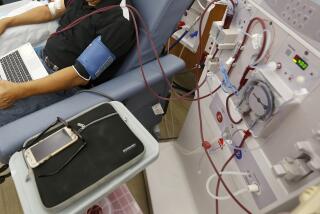Trump signs order directing government to overhaul care for kidney disease

President Trump signed an executive order Wednesday directing the government to revamp the nation’s care for kidney disease so that more people whose kidneys fail have a chance at early transplants and home dialysis.
Trump said his order was intended to increase the supply of donated kidneys, make it easier for patients to undergo dialysis in the comfort of their own homes and prioritize the development of an artificial kidney.
“It’s truly an exciting day for advancing kidney health in our country,” Trump said.
The changes won’t happen overnight — some of the initiatives will require new government regulations.
Because a severe organ shortage complicates the call for more transplants, the administration will try to ease the financial hardships for living donors by reimbursing them for expenses such as lost wages and childcare, the president said.
“Those people, I have to say, have never gotten enough credit,” Trump said. “What they do is so incredible.”
Another key change: steps to help the groups that collect donations from the deceased to do a better job. Officials cited a study that suggested long term it might be possible to find 17,000 more kidneys and 11,000 other organs from deceased donors for transplant every year.
Federal health officials have made clear for months that they intend to shake up a system that today favors expensive, time-consuming dialysis in large centers over easier-to-tolerate at-home care or transplants that help patients live longer.
“Right now, every financial incentive is toward dialysis and not toward transplantation and long-term survivorship,” said Health and Human Services Secretary Alex Azar, whose father experienced traditional and at-home dialysis before getting a transplant from a living donor. Azar, speaking at a Senate hearing in March, added, “And you get what you pay for.”
About 30 million American adults have chronic kidney disease, costing Medicare a staggering $113 billion.
Did your health plan deny you care? You can fight back. Here’s how »
Careful treatment — including control of diabetes and high blood pressure, the two main culprits — can help prevent further kidney deterioration. But more than 700,000 people have end-stage renal disease, meaning their kidneys have failed, and require either a transplant or dialysis to survive. Only about a third received specialized kidney care before they got so sick.
More than 94,000 of the 113,000 people on the national organ waiting list need a kidney. Last year, there were 21,167 kidney transplants. Of those, 6,442 were from living donors, according to the United Network for Organ Sharing, which oversees the nation’s transplant system.
“The longer you’re on dialysis, the outcomes are worse,” said Amit Tevar, a transplant surgeon at the University of Pittsburgh Medical Center, who praised the Trump administration initiatives.
Too often, transplant centers don’t see a kidney patient until he or she has been on dialysis for years, Tevar said. And although any transplant is preferable, one from a living donor is best because those organs “work better, longer and faster,” Tevar said.
Among the initiatives that take effect first:
- Medicare payment changes that would provide a financial incentive for doctors and clinics to help kidney patients stave off end-stage disease by about six months.
- A bonus to kidney specialists who help prepare patients for early transplant, with steps that can begin even before they need dialysis.
- Additional Medicare changes so that dialysis providers can earn as much by helping patients get dialysis at home as in the large centers that predominate today. Patients typically must spend hours three or four times a week hooked to machines that filter waste out of their blood.
Home options include portable blood-cleansing machines, or what’s called peritoneal dialysis that works through an abdominal tube, usually while patients are sleeping.Today, about 14% of patients in kidney failure get at-home dialysis or an early transplant. By 2025, the goal is for 80% of people with newly diagnosed kidney failure to have one of those options, officials said.
These changes are being implemented through Medicare’s innovation center, created under the Obama-era Affordable Care Act and empowered to seek savings and improved quality. The Trump administration is relying on the innovation center even as it argues in federal court that the law that created it is unconstitutional and should be struck down entirely.
Other initiatives will require new regulations, expected to be proposed later this year. Among them:
- Allowing reimbursement of lost wages and other expenses for living donors, who can give one of their kidneys or a piece of their liver. The transplant recipient’s insurance pays the donor’s medical bills. But they are out of work for weeks recuperating, and one study found more than a third of living kidney donors reported lost wages, a median of $2,712, in the year following donation. Details about who pays — and who qualifies — still have to be worked out.
- Clearer ways to measure how well the nation’s 58 organ procurement organizations collect donations from deceased donors. Some do a better job than others, but today’s performance standards are self-reported, varying around the country and making it hard for government regulators or the OPOs themselves to take steps to improve.
“Some OPOs are very aggressive and move forward with getting organs allocated and donors consented, and there are those that are a little more lackadaisical about it,” said Pittsburgh’s Tevar. Unlike the medical advances in transplantation, “we haven’t really made big dents and progress and moves in increasing cadaveric organs or increasing live-donor options.”
More to Read
Get the L.A. Times Politics newsletter
Deeply reported insights into legislation, politics and policy from Sacramento, Washington and beyond. In your inbox three times per week.
You may occasionally receive promotional content from the Los Angeles Times.






